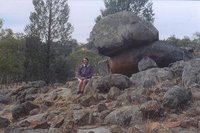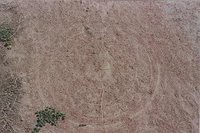In April this year Jan and I produced, in PDF format, Issue No. 1 of a Newsletter we titled Ochre Archives, which we emailed to a wide group of family and friends. Since then we have set up this blog site and are in the latter stages of finalising Issue No. 2, which will this time be circulated to most people via a link to this blog site - although we will still produce a copy in PDF format for our own purposes. Issue No. 2 makes references to the prior edition, so in the interest of continuity and ease of access for our readers we have reproduced the content of Issue No. 1 below.
THE FOLLOWING WAS WRITTEN IN APRIL 2006
Introduction
Welcome to the first edition of ‘Ochre Archives’, which aims to record and share discoveries and events connected with our farm “Ochre Arch” near Grenfell in New South Wales, Australia.
 We recently changed the property name to Ochre Arch when we learned that Aborigines once mined ochre from under the natural ironstone arch in one of the creeks. Here is a picture of the arch:
We recently changed the property name to Ochre Arch when we learned that Aborigines once mined ochre from under the natural ironstone arch in one of the creeks. Here is a picture of the arch:We’ve owned the farm since late 2003 and had access to it through family since 1979. Despite many walks through the scrub and around the place we have yet to see it all given the size, terrain and vegetation. Every time we visit, without exception, we learn or observe something new or different. We figure if it’s exciting for us then it might at least be interesting to others, and felt a newsletter was probably the best way of sharing the information.
Hyperlinks have been included throughout the document, providing access to additional information for those who are interested.
Findings from the last trip to the farm
Trees and Shrubs
We found 3 Native Cherry or Cherry Ballart (Exocarpos cupressiformis) trees, and confess to never even having heard of them before. They are usually co-located with eucalyptus, and are parasitic. Unlike mistletoe they can survive if the host plant dies. European settlers used them as Christmas trees, and a web site we found suggests that Aboriginal use included:
· Sap - used as a snake bite treatment,
· Twigs - provided a tonic and astringent, valuable as a solution for stopping infection,
· Leaves - used to create a smoke for repelling insects during the summer months.
The web site also states: “Of interest, is the use by north eastern Australian aboriginals, of the closely related species Exocarpus latifolius (Broad-leaved native cherry). This plant had yellow fruit, which was again eaten when very ripe. However, its bark was soaked to provide a tonic for the sterilization of tribal women, no longer allowed to give birth due to tribal traditions.”
We contacted Sue Hudson (Sue is an Aboriginal archaeologist, and visited our farm in September 2005) for some additional thoughts on the Cherry Ballart. She confirmed much of the above and suggested caution in eating the fruit given that the Aborigines used it to induce abortions! Good advice, we reckon.
Mikla Lewis (a local resident with a deep knowledge of, and passion for, native flora and fauna) visited and pointed out many species of plants that we did not know the names of, including:
· White Box. (Eucalyptus albens) trees
· Bull-oak (Casuarina luehmannii) trees
· Drooping She-oak (Casuarina stricta) trees
· Currawang (Acacia doratoxylon) wattle
· Tumbledown Red Gum (Eucalyptus dealbata) trees
· Dwyer’s Red Gum (Eucalyptus dwyeri) trees
Rock Formations
It also turns out we have our own mini “Hanging Rock”, as you can see in this picture:

Reptiles
We spotted 2 young Eastern Bearded Dragons (Pogona Barbata) in different paddocks.
Birds
The following 4 new bird species were sighted, taking the total to 49 so far:
· Brown Treecreeper (Climacteris picumnus) – listed as ‘vulnerable’ on the NSW Threatened Species website
· Little Pied Cormorants (Phalacrocorax melanoleucos)
· Jacky Winter (Microeca fascinans)
· Zebra Finch (Taeniopygia guttata)
Water
 Harvey Matthews (Harvey & Jacquie lease Ochre Arch) commented despite the fact that there has not been significant rain since last November the fresh water natural spring started ‘producing’ a lot more water about 1 month ago; presumably as a consequence of the 500 mm of rain that fell during the cooler months of 2005.
Harvey Matthews (Harvey & Jacquie lease Ochre Arch) commented despite the fact that there has not been significant rain since last November the fresh water natural spring started ‘producing’ a lot more water about 1 month ago; presumably as a consequence of the 500 mm of rain that fell during the cooler months of 2005.Patterns
 A single stem of grass on bare ground, assisted by wind, created this design. The circle is approx. 800 mm in diameter.
A single stem of grass on bare ground, assisted by wind, created this design. The circle is approx. 800 mm in diameter.Native Animals
We spotted a large almost black Eastern Wallaroo (Macropus robustus robustus).
Experimentation
During the past year several people have suggested to us that they have had success in restoring bare ground and ‘filling in’ small gullies by placing ‘anything that was alive and is now dead’ (such a dead sheep, branches etc.) on the site.
 Near the cottage on the farm is a patch of bare ground on the edge of the creek caused, in part, about half a century ago when the top soil was pushed into the creek to create a bank for vehicles to cross. We’ve decided to try out the idea as you will see in the accompanying photo, and have been careful to make sure the dead branches are not in places where they would float and wash down the creek following downpours (potentially damaging fences). It will be interesting to see what happens. Not that we want this to happen, but it’s possible we may have created an ideal habitat for rabbits given they like both cover and adjacent bare ground.
Near the cottage on the farm is a patch of bare ground on the edge of the creek caused, in part, about half a century ago when the top soil was pushed into the creek to create a bank for vehicles to cross. We’ve decided to try out the idea as you will see in the accompanying photo, and have been careful to make sure the dead branches are not in places where they would float and wash down the creek following downpours (potentially damaging fences). It will be interesting to see what happens. Not that we want this to happen, but it’s possible we may have created an ideal habitat for rabbits given they like both cover and adjacent bare ground.In Closing
We welcome any feedback you might have via email to pdiprose@optusnet.com.au. Please also let us know if you do not want to receive future editions of Ochre Archives, or perhaps you want to visit the property (please - only when we are at the farm – this is for Health & Safety and Security reasons).
We hope this finds you happy and well.
Kind regards…
Phillip & Jan Diprose
Link to: Ochre Archives Newsletter - Issue No. 2
Link to: Ochre Archives Newsletter - Issue No. 3
No comments:
Post a Comment